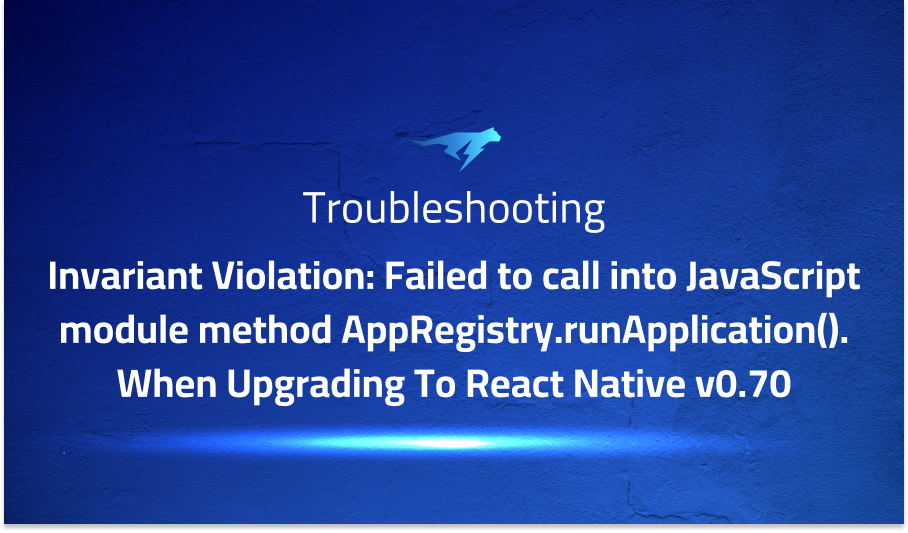

Invariant Violation: Failed to call into JavaScript module method AppRegistry.runApplication(). When Upgrading To React Native v0.70
Explanation of the problem
The problem reported is related to an upgrade from version 0.68.1 to version 0.70.0 of React Native (RN). The upgrade process was successful, as the app builds fine in Xcode and the splash screen appears on the Simulator. However, the app crashes shortly after, with an error message stating: “ERROR Invariant Violation: Failed to call into JavaScript module method AppRegistry.runApplication(). Module has not been registered as callable”. The error message suggests that there might be an issue with the application entry file path, a corrupt JS bundle, or an early initialization error when loading RN.
Based on the output of npx react-native info, the issue might be related to a missing Android SDK, as it is not found in the list of installed SDKs. However, the SDKs listed include iOS SDKs such as DriverKit 21.4, iOS 15.5, macOS 12.3, tvOS 15.4, and watchOS 8.5. Additionally, the output reports that Yarn is not installed, but npm is available in version 8.5.5. This might be a potential cause of the error, although further investigation is needed to confirm it.
Troubleshooting with the Lightrun Developer Observability Platform
Getting a sense of what’s actually happening inside a live application is a frustrating experience, one that relies mostly on querying and observing whatever logs were written during development.
Lightrun is a Developer Observability Platform, allowing developers to add telemetry to live applications in real-time, on-demand, and right from the IDE.
- Instantly add logs to, set metrics in, and take snapshots of live applications
- Insights delivered straight to your IDE or CLI
- Works where you do: dev, QA, staging, CI/CD, and production
Start for free today
Problem solution for Invariant Violation: Failed to call into JavaScript module method AppRegistry.runApplication(). When Upgrading To React Native v0.70
The error message “Invariant Violation: Failed to call into JavaScript module method AppRegistry.runApplication()” can be caused by various reasons when loading React Native. One solution to avoid this error is to check whether the import of react-native-gesture-handler is correctly done in the root file. In previous versions, this import had to be done at the top of the root file. However, in the newer version, it must be imported in App.js instead.
To fix the issue, it is recommended to wrap the entire app with the new GestureHandlerRootView provided by react-native-gesture-handler in App.js. The code block should be placed inside the render method of App.js, and the style of the GestureHandlerRootView should have a flex value of 1 to ensure that the app is properly displayed. This allows the GestureHandler to be correctly initialized and registered with the AppRegistry.
In summary, if the error message “Invariant Violation: Failed to call into JavaScript module method AppRegistry.runApplication()” is encountered, it could be caused by issues when loading React Native. One possible solution is to ensure that the import of react-native-gesture-handler is properly done in App.js instead of the root file, and wrap the entire app with the new GestureHandlerRootView in App.js to initialize and register the GestureHandler with the AppRegistry.
Other popular problems with React
Problem: Virtual DOM performance issues
One of the most common problems with React is related to performance issues with the virtual DOM. The virtual DOM is a mechanism that React uses to update the view in response to changes in the underlying data. When the state of a component changes, React will first update the virtual DOM, and then update the actual DOM. This process can be slow, particularly if the component has a large number of child elements.
Solution:
To solve this problem, developers can use techniques such as shouldComponentUpdate, which allows components to control when they should re-render, or use the React.memo higher-order component, which only re-renders a component when its props change. Additionally, developers can use the React DevTools extension to identify and optimize components that are causing performance bottlenecks.
Problem: Managing state and props
Another common problem with React is related to managing state and props. React components can have both state and props, which are used to store and pass data between components. However, when a large number of components need to share and update data, it can become difficult to manage and maintain the flow of data.
Solution:
To solve this problem, developers can use a centralized state management library such as Redux or MobX. These libraries allow developers to store all of the application’s state in a single place, and provide a mechanism for updating and sharing that state across all components. Additionally, developers can use the useContext and useReducer hooks to manage state within a component tree.
Problem: Handling Forms
React forms can also be a source of pain for developers, as they require a lot of boilerplate code to handle changes and validation. Forms can be tricky to handle because they often involve multiple inputs, which need to be controlled and updated correctly.
Solution:
To solve this problem, developers can use libraries such as Formik and react-hook-form to handle forms in React. These libraries provide simple APIs for controlling form inputs and handling validation. Additionally, developers can use the useState and useEffect hooks to handle form input changes and validation manually.
A brief introduction to React
React is a JavaScript library for building user interfaces. It was developed by Facebook and is now maintained by a community of developers. React allows developers to build reusable UI components, which can be composed to create complex user interfaces. React uses a virtual DOM (Document Object Model) to improve performance by limiting the amount of changes that need to be made to the actual DOM. The virtual DOM is a lightweight representation of the actual DOM and it allows React to compare the current state of the virtual DOM with the previous state, and make only the necessary changes to the actual DOM.
React follows a component-based architecture, where the user interface is broken down into small, self-contained components that can be easily reused and composed to create more complex UI. React components can have both state and props, which are used to store and pass data between components. React also provides a mechanism for handling events, such as user clicks, through the use of event handlers. React also provides a set of lifecycle methods that developers can use to control when a component is created, updated, and destroyed. This allows developers to control the behavior of their components and optimize performance.
Most popular use cases for React
- Building reusable UI components React allows developers to build reusable UI components that can be composed to create complex user interfaces. Each component is self-contained and can manage its own state and props. This allows developers to easily reuse and maintain their code.
- Dynamic User Interfaces React uses a virtual DOM to improve performance by limiting the amount of changes that need to be made to the actual DOM. This allows developers to build dynamic user interfaces that can efficiently update in response to changes in the underlying data.
- Building complex web applications React can be used to build complex web applications that require efficient updating of dynamic data. React also provides a set of lifecycle methods that developers can use to control when a component is created, updated, and destroyed. This allows developers to control the behavior of their components and optimize performance.
class Counter extends React.Component {
constructor(props) {
super(props);
this.state = { count: 0 };
}
handleClick = () => {
this.setState({ count: this.state.count + 1 });
}
render() {
return (
<div>
<p>Count: {this.state.count}</p>
<button onClick={this.handleClick}>
Increment
</button>
</div>
);
}
}
It’s Really not that Complicated.
You can actually understand what’s going on inside your live applications.




